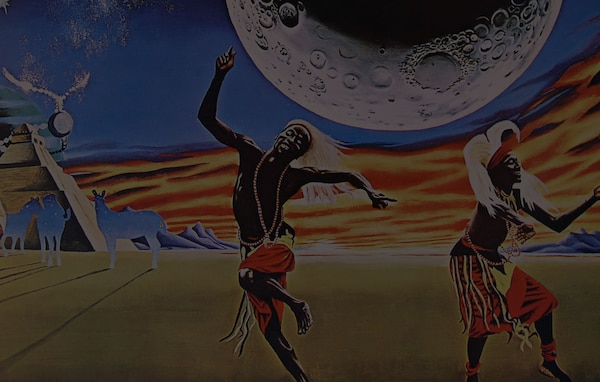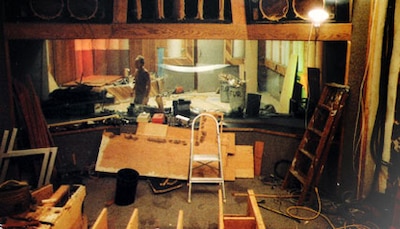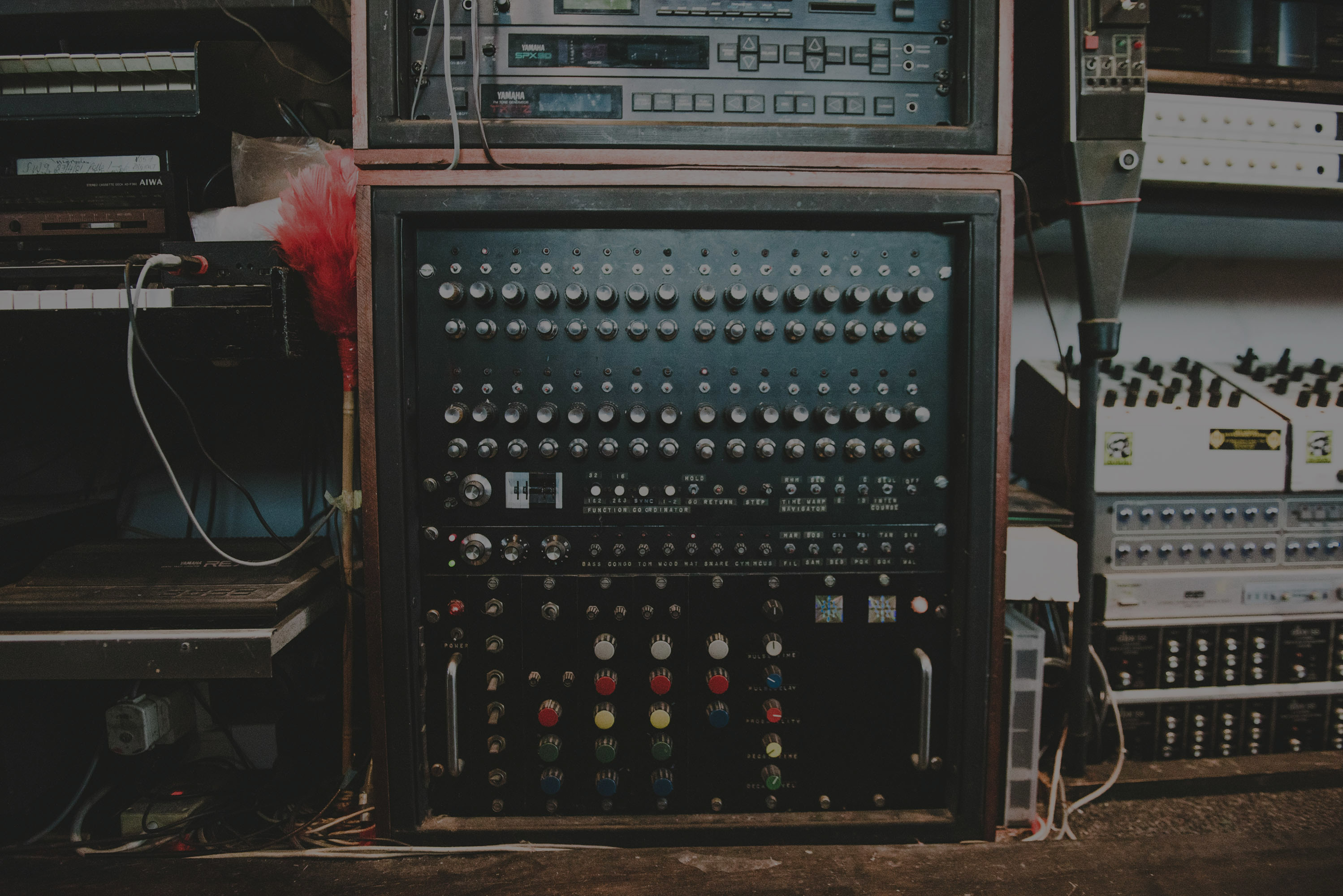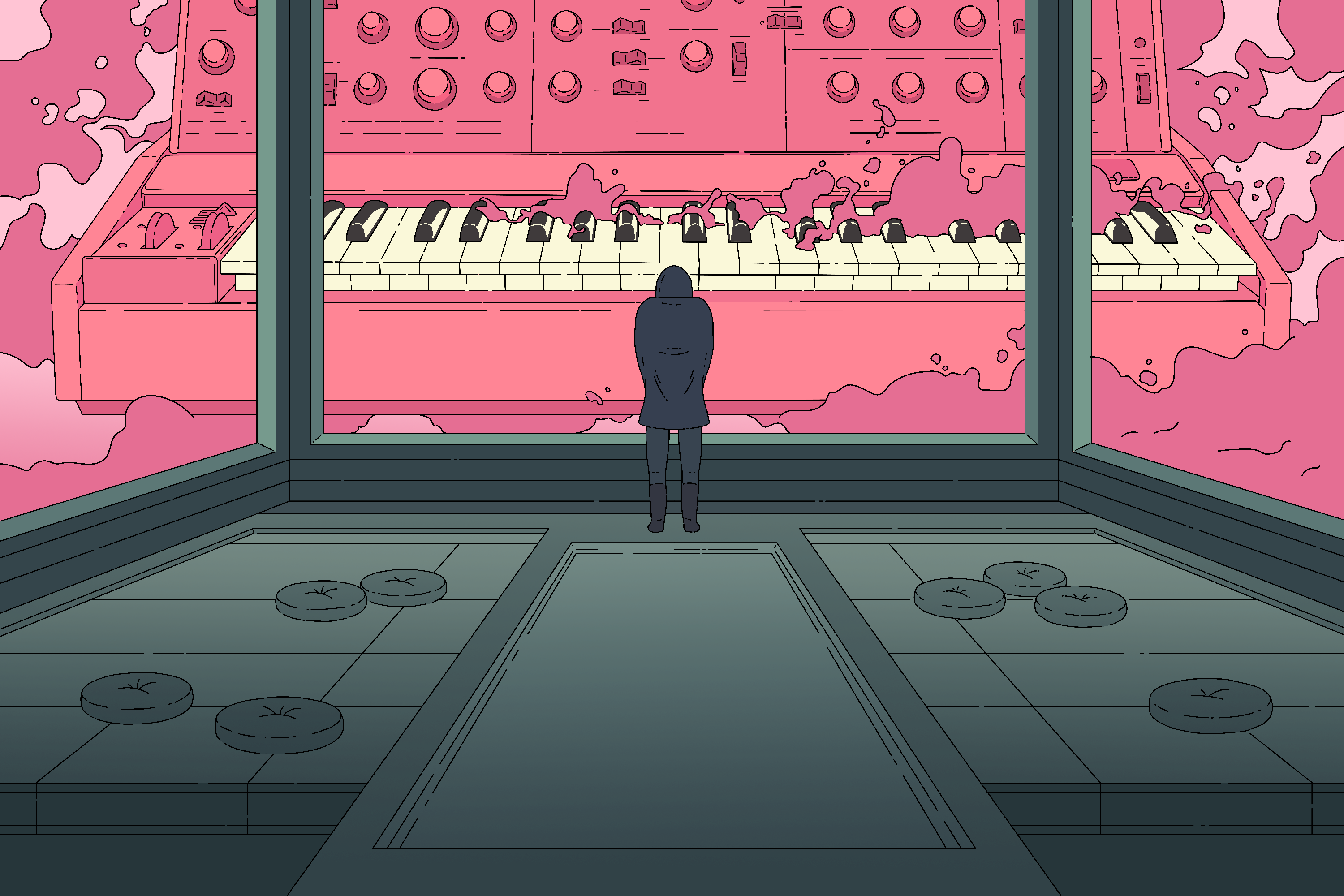Wearing A Really Different Fur
How Patrick Gleeson introduced the synthesizer to Herbie Hancock and changed jazz in the process

“There was definitely some conceptual confusion at the beginning of this. They used to come up to me and say I looked like a goddamn telephone operator.” So says Dr. Patrick Gleeson, in reference to his time touring with Herbie Hancock’s Mwandishi band in 1972. The misunderstanding came from his unusual role in the group: While the six other musicians riffed and improvised on conventional instruments, Gleeson was busy dealing with patch cables, generating a cacophony of unusual whirrs and percolating gurgles with his ARP 2600 modular synthesizer.
The confusion makes perfect sense in hindsight: The meeting of Hancock and Gleeson brought the once separate disciplines of jazz and experimental electronic music together in a very big and serious way. How did they come together? The answer is buried deep in the lysergic atmosphere of San Francisco in the 1960s, and the music studio-funded commune Different Fur Trading Company, which Gleeson co-founded and later owned.
Everyone was out of their heads on acid, so no matter what you did they’d say, “Wow, this sounds great!”
Patrick Gleeson grew up in Seattle, an aspiring jazz pianist. But he put his dreams on hold to pursue a PhD in 18th Century English Literature, which he used to land a job teaching at San Francisco State University. While teaching there, he began to experiment with LSD, and found himself on a path that led back towards music, albeit via a very different route.
“It was electronic music, not jazz. And when I say electronic music, I really mean musique concrète – tape manipulations and that sort of thing. There was no real distinction at the time,” he recalls. He began using equipment from San Francisco State’s AV department to go out and record sounds from his everyday life, which he would then splice with a razorblade. “We’d put on performances of this stuff at places like The Avalon Ballroom or at some theater in the Haight. We’d do it between rock groups. You know? You’d bring your shit in and turn it on. And everyone was out of their heads on acid, so no matter what you did they’d say, ‘Wow, this sounds great!’”
As an example of his early experiments with music, he cites a piece composed for Anna Halprin, the post-modern dancer, and her troupe, “I had a big malt box with controls, and I had a tape recorder under every seat in this theater, and I’d trigger sounds on them. For the climactic end, I’d turn the lights off and gun my motorcycle, which I’d brought on stage. It was really primitive stuff.”
Through his performances, he became involved with the Divisadero Street Tape Music Center, a progressive workshop dedicated to the exploration of avant-garde sound. There he became acquainted with people like Steve Reich, Terry Riley, Morton Subotnick and Don Buchla. “I first got into synthesizers at the Tape Music Center, through the original Buchla box. I had been listening to some really primitive stuff on Folkways, mostly European, some American, and I figured, I can do this. So I began doing pieces on the Buchla, and when they moved to Mills College, I pretty much abandoned music concrete. But as I used the Buchla, I became more dissatisfied with it. I wanted to at least have the option of tonality, and that was just not what Don was about.”
I remember walking on campus one day and reading the school newspaper. The headline was, “English Professor Named Commie Dupe.” And of course, I realized, “Oh shit, it’s me!”
While he was exploring these new musical frontiers in his private life, he was also actively engaged in the political drama quickly escalating at San Francisco State University. Gleeson was first arrested in 1967 for protesting an on-going campus policy that supported the Vietnam draft. The following year, he continued to participate in protests leading up to the establishment of what is now known as the College of Ethnic Studies. However, due to his visible involvement, Gleeson was targeted by conservative forces within the school’s bureaucracy. “I was a strike leader, I’d hired a Black Panther to be one of my TAs. I didn’t get any support from my department, and I just thought they were just so spineless. In fact, I remember walking on campus one day and reading the school newspaper. The headline was, ‘English Professor Named Commie Dupe.’ And of course, I realized, ‘Oh shit, it’s me!’”
Gleeson was advised to sit out of future teacher’s strikes due to his arrest record. And, as he sat and watched the strikes fail from the sidelines, he began to get angry. Worse still, his wife at the time had an affair. He snapped. “So my marriage was on the rocks, we’d lost the teacher’s strike, and now I was supposed to go back and act like nothing was wrong, so I said, ‘Fuck it. I’m not going back.’“
Instead, he decided to build a music studio. “I went to my dad, who was successful in business, and told him what I wanted to do, and asked for $20,000. He said yes. Meanwhile, my friend John Viera, who was working at an art college, had one of the first Moog Modulars. But he didn’t have enough money to totally fill it out. So I offered to partner up with him.” The two set up camp in Viera’s Mission District apartment, with a rudimentary studio in the bedroom and a control room in the closet.
Their makeshift studio brought in little money, and Gleeson quickly realized that his $20,000 would not go as far as he thought. “I knew this guy that supplied rather exotic drugs to the Hell’s Angels. So I started dealing to help fund what would later become Different Fur. I was selling grass, but he also had MDA, and I remember buying that and sending my guy out to Ken Kesey’s ranch. Unfortunately, he gave it all away and screwed all the girls,” he laughs. “So John and I, we realized that if we’re going to really do this, we can’t do it out of a closet, so we gave some guy studio time in exchange for finding us a building.”

What they found was a three-story storage building in San Francisco’s Mission District. The idea was to create a commune that would be funded by Gleeson and Viera’s studio work. “We moved in en masse and had about 12-14 people living in there. The ’60s were really about having no boundaries, and we didn’t have them then.” The only thing missing was a name for the studio, which Gleeson procured from poet Michael McClure, “Remember, this was the time of Jefferson Airplane and Sopwith Camel and harkening back to the frontier days. So Michael says, ‘Really Different Fur Trading Company.’ And I go to everyone at the commune and they grumble about it. And I said, ‘Look, it’s this guy’s job.’ And they said, ‘Ok, fine, but do we have to keep the ‘really’?’“ So we dropped it, and that was that.”
Gleeson would go into the studio late at night, cue up Miles Davis’ Bitches Brew, and then record himself as he patched his Moog and played across the record’s already avant-garde surface.
The studio boomed, doing commercial jingles for ad agencies and providing recording services for groups like Jefferson Starship. But as time went on, Gleeson found himself drifting back towards his first passion in life, jazz. He’d go into the studio late at night, cue up Miles Davis’ Bitches Brew, and then record himself as he patched his Moog and played across the record’s already avant-garde surface. “I just did it because I wanted to know what it sounded like, and it sounded great.”
Simultaneously, Herbie Hancock had begun a transition that would lead him inevitably towards Gleeson. With the release of Mwandishi in 1970, he charted an experimental course influenced by Hancock’s own work with Miles Davis on “In a Silent Way.” The sextet of Herbie Hancock, Buster Williams, Billy Hart, Eddie Henderson, Bennie Maupin, and Julian Priester began to push in a direction that suggested not only a fusion of rock, funk, and jazz but also electroacoustic music as well. Instead of using a traditional acoustic piano throughout Mwandishi, Hancock played a Fender Rhodes connected to an Echoplex tape delay. With this combination, Hancock was able to create cascades of warping tones that, through deft tape manipulation, sound nearly as alien, futuristic, and texturally vibrant as a modular synthesizer.
As Gleeson’s work expanded, he began to take his synthesizer knowledge to other studios around San Francisco. This is how he met David Rubinson, an independent producer who was slated to work with Herbie Hancock. Confident in his abilities, Gleeson approached Rubinson, “I told him about what I’d been doing with Bitches Brew and said, ‘I’d like to get in on this. I can do this.’ And so, David went to Herbie and (I later found out) said, ‘Look, there’s this guy, he’s not in your league – which, fair enough, who is – but he’s been doing synthesizer programming for me and he can play. But what he can really do is set the machine up for you.’”
At the time, Hancock and the Mwandishi band were recording Crossings, the daring follow-up to Mwandishi. Rubinson advised Hancock to bring some of the already recorded material to Different Fur to see what they might add. “So Herbie comes down to the studio with the material they’d already recorded. I’d just bought a 16 track, and it had a loop function. So he tells me to set everything up and he puts on ‘Quasar.’ So we’re listening and he says, ‘Can we hear that again?’ We loop it. He says, ‘I’m thinking of something we can add here.’ So I start patching the Moog 3, and I’m just rushing like crazy because I think I have no time to get this shit together. And then he says, ‘Okay, did you record that?’ And I tell him no because I was setting up the synthesizer for him to play. And Herbie being Herbie, he liked what I was doing and says, ‘Well, why don’t you just keep playing, I’ll be back later, just keep going.’ And by the time he’d come back the next day I’d overdubbed an entire side of the album.”
That Gleeson only appears on one side of Crossings only makes his contributions to the group more apparent. The album’s A-side, “Sleeping Giant,” is a sprawling epic of grinding funk and tripped-out jazz, yet it stays firmly in the mold of Mwandishi. Flip the record over and you’ll find “Quasar,” the first Herbie Hancock tune to feature Gleeson’s work. Immediately, the band is taken in a completely different direction, with whirling modulations and shooting tones that seem to ride between the acoustic interstices created by the band. But more importantly, it sounds like a conversation between instruments as opposed to a superimposition.
“Herbie really liked it,” Gleeson remembers, “He liked it so much that he gave me a production credit on the album. The only reason I didn’t play on more of Crossings was because of some issue with the recording studio they were using. They got locked out. So I didn’t get on ‘Sleeping Giant,’ but I did do some overdubbing with a mellotron on ‘Water Torture.’ It was my first time being credited on a jazz album, so that was big. And pretty soon, Herbie called me up and asked if I wanted to go on tour with them. Of course I said yes.”
But performing and improvising live came with its own set of challenges. The first of which involved Gleeson’s beloved Moog 3, which was too large to carry around on the road. After some trial and error, he settled on the then just released ARP 2600. Though comparably portable, it was still a modular synthesizer without internal memory, which meant that Gleeson had to reconstruct his sounds organically.
If you dropped a pencil, Herbie could develop multiple variations on the theme of a dropped pencil by the time it struck the floor.
“So I had the back panel, some filters, a sample/hold generator and all that. And I could put them together in any combination of ways. On top of that I had a wah-wah pedal and an Echoplex. And when the band was playing, things were moving so quickly that I was forced to think like a jazz musician. I’d take a patch cable and plug it in, then plug another, and that would last until the band moved on to something else. I’d change patches maybe 300 times a night. I had 20-35 patch cords, and I thought I’d color code the patch cords to help myself, but there wasn’t time for that — you’d just grab a cord. If you had to look for the color of the wire, you were already too late. So you just put the cord in the oscillator and you were on your way,” he says of the performances. “And these guys were fast. If you dropped a pencil, Herbie could develop multiple variations on the theme of a dropped pencil by the time it struck the floor. I tell you, by the time we got off the road, I knew that instrument better than any other instrument I’ve had in my life.”
Gleeson’s addition to the band was met with both internal and external resistance. He was, after all, a white synthesizer player amongst a sextet of traditional black jazz musicians. “I remember, Herbie’s sister Jean gave everyone in the band Swahili names, and mine was Bwana. And if you don’t know what that is, then it’s basically the great white hunter – whitey – with pith helmet, khaki shorts, and the works. They weren’t happy with me as the first white guy in the band. And when I went on tour with them in 1971, I was surprised they didn’t kill me with the shit they had to go through.”
Beyond the pale complexion of his skin, his band mates held a dim view of his instrument. “Our first and only rehearsal was supposed to be Herbie, Buster, and me. Buster took forever to get there, and when he did, he didn’t even take his bass completely out of its case. It was like, well, when you have your pants around your ankles, and you’re doing it, but you’re ready to split at any second. He looks at me and he says, ‘What’s that thing called anyway?’ and I replied, ‘It’s a synthesizer.’ Then he gave me this look like I was the dumbest white boy alive, ‘I know it’s a synthesizer, what kind of synthesizer?’ And I say, ‘ARP 2600.’ And he goes, ‘Hmmm, sounds like a vacuum cleaner.’ We rehearsed two or three tunes and that was it,” he says. “There’s still some bad feelings towards me. I don’t know if even today everyone in the group fully accepts me as a part of the jazz experience.”
Those feelings aside, Gleeson looks back on his time with the band extremely fondly, “It would be really hard. Sometimes I wouldn’t be listening, and I’d get lost. And I’d just say, what the fuck am I doing? But then there’d also be these nights where it would all click and it’d be so powerful. It was like doing drugs, with all the mind expansion, but without the downside. It was like I was touching an intelligence beyond myself.”
Though there are no official recordings of Gleeson’s live work with the group, there are a number of bootlegs floating around on the internet. Listening to these recordings, which cover his brief tenure in the band from ‘72-’73, it’s not hard to imagine how the public would have been confused by his role. Outside of the studio, his synthesizer takes on a raw presence, cutting a distinctly alien contrast to the warmth of his fellow musicians’ chosen instruments. “Quasar” live becomes a kind of battle between the acoustic and electronic, with Bennie Maupin’s flute sounding like a desperate bird trying to fly out of an asteroid belt. It’s more exciting than on the record, but also more challenging, too.
With Crossings, Gleeson was initiated into the band. But it was really on Sextant, the last and final recording of the Mwandishi outfit, that he became fully integrated. Unlike its predecessor, it was recorded live, with minimal overdubbing. The result was an LP of high-tech jazz that was far ahead of its time, with Gleeson’s synths taking a more active role in the overall dialog of the music.
The album leads with “Rain Dance,” an often sampled work that features an iconic funky synthesized drum line that runs beneath the length of the song. “For that I was using this thing called a Random Resonator, which was this box with a sample and hold and a few other analog circuits that you could control from the face, with a knob that allowed you to control the degree of randomness. We set it up, let it play, recorded it, and chose a sequence that we then looped.”
Later, on “Hornets,” the whole band comes together to create a chaotic swarm of sound. Here too, Gleeson’s synthesizers are more prevalent, creating a churning vortex of klaxons, pixelated blurts, and panic-inducing high frequencies that create a vessel for Hancock’s aggressive keyboard playing and Bennie Maupin’s unusual – yet terrifying – use of the kazoo.
All of this experimentation came at a price: Both Crossings and Sextant were commercial failures, and Hancock went on to pursue a more accessible fusion of jazz and funk on his next record (with his next band), Head Hunters. Though Gleeson helped Hancock record parts of this album at Different Fur, he no longer contributed as a member of the group. The role of the synthesizer player had been taken over by Hancock himself, a move foreshadowing the extremely synthesizer heavy (and commercially successful) Future Shock.
Here it is, shit, 50 years later and I’m still trying to figure out what it is I want to do.
Gleeson recalls his last days with the band, “There were a lot of bad feelings, I don’t think it really ended the right way. Herbie was on a thing about money, but I’m not sure if it was really about that. Originally I was actually going to continue on with him, but I came to understand that Herbie was now into synthesizers in a way that very few other jazz musicians on the planet were.”
The two paths diverged. Hancock went on, and Gleeson returned to Different Fur Trading Company, where he bought out his partner, and took on sole ownership of the recording studio. He went in many different directions afterwards: He recorded countless bands at Different Fur, lent his synthesizer talents to the jazz world when asked (as on Charles Earland’s Leaving This Planet or Julian Priester’s Love, Love), recorded experimental electronic compositions of his own, and then later enjoyed a career in Hollywood as a film score composer. (He lent his talents as “Master Synthesist” to Francis Ford Coppola for the soundtrack to Apocalypse Now.)
Today, looking back at a life well lived, he still finds himself returning to the early ’70s. He lives in Los Angeles; retired in a house he built himself that resembles the kind of precarious yet organized brutalism of sculptor Richard Serra. As we look out on the canyon below, he says, “Here it is, shit, 50 years later and I’m still trying to figure out what it is I want to do. I think I came closest with Herbie, and now I’m trying to think up or imagine a way to do live performance today with electronic music in a truly improvised environment, with emotion.”
We head to his music studio to hear a few of his latest compositions, and when he takes me in, I can’t help but notice that his current setup is Ableton Live, a Push on a stand, and a keyboard. It provokes an unusual question, where would electronic music be today if he didn’t decide to drop everything in 1968?
Header image © Discog

